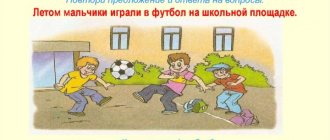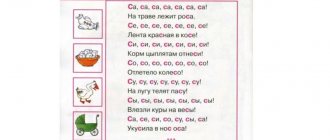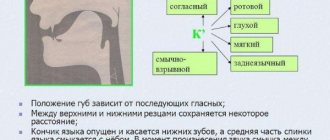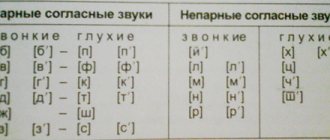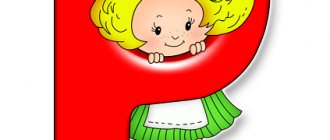After the stage of sound production, they move on to consolidating it in coherent speech. This is one of the most difficult stages, because you need to teach the child the skills of self-control of speech. The longer the incorrect pronunciation persists, the more difficult it will be to form the correct articulatory pattern. Automation of the sounds Ш and Ж and other phonemes that have similar characteristics is carried out separately. This is done to prevent their mixing.
It is worth moving on to the automation stage only after the child has managed to pronounce the desired sound correctly in isolation. After pronunciation is established, they move on to practicing it in syllables. All work on fixing sound in coherent speech is based on the principle of gradual complication of speech material.
Working with sound in syllables
Automation Ш, Ж in syllables is carried out in the following order:
- straight lines (SHA, ZHA, etc.);
- reverse (ASh, etc.), the sound Ж in these syllables is not practiced, because it is “stunned”;
- between vowels (ASHA, AZHA, etc.);
- with a combination of consonants (SHKA, ZhDA, etc.).
Tasks for children to reinforce sounds must be accompanied by visual material. Be sure to do articulation gymnastics at the beginning of the lesson to prepare the speech apparatus.
Isolated pronunciation is added to the practice of phonemes in straight syllables. Speech material is also gradually increased in volume: when moving on to a new type of syllables, first add 1-2 tasks with already worked out combinations.
Examples of tasks
To consolidate the correct pronunciation of syllables, the speech therapist uses special paths, “walking” along which the child pronounces the desired combination of sounds. At the beginning of the work, the adult gives a sample of correct pronunciation, then pronounces the material together with the child. Then the baby repeats on his own.
Examples of syllabic tracks:
- SHA-SHO-SHU-SHI;
- ZHA-JO-ZHU-ZHI;
- SHA-ASH-SHU-ISH;
- AZHA-OZHO-ZHU, etc.
At this stage, pure tongues are used. They are aimed not only at practicing correct pronunciation of syllables, but also at gradually introducing sound into words.
Examples of pure talk:
- SHA-SHA-SHA - we bathe the baby;
- SHO-SHO-SHO - rest well;
- ZHA-ZHA-ZHA - we saw the Snake;
- ZHU-ZHU-ZHU - I look at the sun.
When automating a certain phoneme, especially at this stage, try not to use words that have a sound with similar characteristics. After the child correctly pronounces Ш and Ж in syllables, the speech material becomes more complex and the stage of consolidation in words begins.
Exercises for making hissing sounds in children
Sound pronunciation is formed in children from the first months of life. The baby pronounces vowels first, and this is an involuntary process. For up to three years, it can distort the sound of certain sounds. And by the age of five or six, before going to preparatory class, the baby should have a fully formed phonetic range.
Speech therapy sessions with a child
On the sound “sh”, speech therapy classes are usually often carried out in the older group of kindergarten. It includes:
- Identifying the problem using speech therapy materials and tables,
- Articulation gymnastics, staging and automation,
- Homework for the child so that the working moment goes more successfully and efficiently. It usually includes various exercises.
When the child has mastered the sound “sh”, you can move on to “zh”. Then the process of differentiating these sounds will be easier, since their articulation is the same. The baby will learn to distinguish where he hisses with calm vocal cords, and where he needs to add vibration.
Important ! As a rule, many children cannot cope with hissing words due to their replacement with “s”. It turns out to be a whistle instead of a hiss. It is worth paying attention to speech when pronouncing sounds. Many children can be helped by comparisons with the movement of a train or the flight of a bumblebee.
Any exercises in speech therapy to produce sounds begin with articulatory gymnastics. This helps prepare the device for proper operation and at the same time relax it.
Articulation gymnastics
In speech therapy classes starting with the letter “w,” articulatory gymnastics occupies a special place. It should be done 2-3 times daily for 5-10 minutes. It is best to stand near a mirror - this way the baby can immediately see his shortcomings and repeat correctly after the adult.
Articulation gymnastics during staging
Exercises:
- "Smile-pipe." Be sure to close your teeth and hold them in this position. Stretch your lips in a smile and fix them for 5 seconds, then stretch them forward into a tube - also for 5 seconds. Repeat 5-7 times.
- "It's hot - it's cold." Open your mouth as if it were hot, and then close it as if it were cold.
- "Pancake." Open your mouth, smile. Then put your tongue on your lower lip, remove it, and put it back again. Keep your mouth smiling.
- "Chatterer." Quickly move your tongue along your upper lip and play “bl-bl-bl.”
Speech development in older preschoolers through play activities
Working in words
You need to choose only those words that contain a practiced syllable. The work is carried out in the following order:
- the sound is at the beginning;
- in the middle;
- at the end.
Automation begins with words with forward and backward syllables. It is advisable to illustrate each name, invite toys to “visit” - all this will make the lesson not only more interesting, but also more effective.
Examples of exercises
Similar to the previous stage, in the first lessons the speech material is spoken by an adult, then together with the student, and then the child repeats it independently. Gradually, when there are more practiced words, the baby names them without prompting from the speech therapist.
At the stage of automation of phonemes in words, work is carried out in parallel on the development of phonetic-phonemic processes. The child is explained where the word has a beginning, middle and end. During the classes, word diagrams are drawn up and tasks for the development of auditory self-control are offered.
At the same stage of automation, the gradual introduction of the automated phoneme into coherent speech begins. They do this using the example of phrases, Ш or Ж can be either in one or in each word:
- Repetition of words:
SHA: ball, cap, puck.
SHU: noise, fur coat, joke.
JA: toad, heat, sting.
And in this way they select words for each practiced syllable.
- The child is asked to listen carefully to the words and correct the adult. An adult deliberately makes mistakes in the pronunciation of the automated sound in some words. This task is aimed at developing auditory control of speech.
- Add the desired syllable to make a word. Pictures are used with children of primary and middle preschool age to make it easier for them to complete this task. For example, given an image of a cap and the second syllable – PKA. The child needs to add a syllable from the proposed options (SHA).
- Repetition of words with two sounds Ш or Ж. For example: bump, panties, kidding, etc.
- Repetition of phrases: On W: grandfather’s checkers, new hat, funny joke, sewing machine.
- On F: a beetle is buzzing, an orange jacket, liquid jelly.
When the child manages to pronounce the sound in words correctly, they move on to a more complex stage of correctional work - automating sounds in sentences. This block is longer in terms of the proposed material, because it is a preparation for the introduction of an automated phoneme into coherent speech.
The benefits of mnemonic tracks with texts:
- Using this technique, it is easier to teach a child to pronounce the sound “Ш” in a coherent text, and therefore in colloquial speech.
- Using mnemonics will develop associative thinking, memory, and attention in children. They will need to match each word with a picture and name it.
- With the help of preposition models, the child will learn to see and hear this “small” word. Children very often connect prepositions with nouns and consider them to be one word (for example, a combination of words ON the table , kids perceive them as one word DESK, etc.). Models of prepositions are presented below.
- With the help of mnemonic tracks, the child will learn to correctly compose sentences and stories. This skill will also be useful in the future when studying at school, because... will teach the child to think figuratively.
Preposition models:
The stories are made in two versions to choose from:
- The first option is signed for the convenience of adults. Tex goes immediately below the picture path. It is intended for individual work with children who do not read.
- The second version of text mnemonic tracks contains only chains of connected pictures. The pictures are larger in size. There is no signed text in the second version so as not to distract reading children. With the second option, you can work both individually and with a subgroup of children. In this case, the text of the story must be printed separately or on the reverse side.
Print the presented pictures on A4 sheets. It is advisable to laminate them, then they will serve you much longer and enjoy doing them.
Or study online on our website.
Lessons on making the sound “sh”
Staging the sound sh during speech therapy exercises can be done using different methods:
- From "s".
- From "t".
- From "r".
- And even from “a, uh, s”
Staging according to the method of Balova O.I.
Proper production of sounds
The most common way to correctly produce the “sh” sound is the “s” method. It is used when there are no defects or problems with the speech apparatus. It is also important that the whistling sound is not pronounced. The baby first begins to pronounce “s”, releases air, and then tenses his tummy a little more when exhaling. This produces hissing. You can also try pressing lightly on the baby's diaphragm (stomach) as you exhale to help the process. Facial expressions should not change, there can be no tension!
Note ! Difficulties in pronouncing sibilants can arise due to improper speech breathing, problems in speech hearing and the individual structure of the frenulum. Therefore, you should first identify the presence of these issues and visit specialists. If they are absent, proceed with sound production with a speech therapist.
From “t” in speech therapy, a diagnosis is made for interdental sigmatism of a child. First, the baby is taught to touch the upper teeth, and then very slowly pronounce the correct sound from “t”.
From “r” the setting is performed only if there is a confident “r”. “R” is pronounced quietly, almost in a whisper, the exhalation pressure decreases - it turns out “sh”.
For vowels, the production of “sh” can be done at home, since it does not require the presence of a speech therapist. The baby pronounces vowels and raises his tongue to the sky with a special tool.
Sound Automation
Automation of “sh” occurs when working with syllables, words and sentences. For a more enjoyable pastime, you can buy special coloring books, pictures, cards or a drawing album, where you can draw illustrations with your child. The baby will draw and speak at the same time, thereby strengthening the skills.
Tasks starting with "sh", coloring book
The following activities are held in the form of a game:
- First, individual syllables are pronounced: sho-sha-shu-she-shi,
- Then the words are added: checker, highway, cones,
- And then you can move on to sentences, tongue twisters: Sasha walked along the highway and sucked on a dryer.
The main task of speech therapy chants and rhythms
